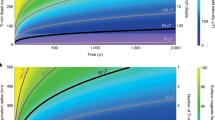Summary
A brief argument is put forward to support the suggestion that dykes such as the members of the Pilandsberg and Tholeiite systems acquire their remanent magnetism in a period of the order of 1 to 10 years. This means that such dykes will cool from, say 550°C to 450°C in that time period.
Similar content being viewed by others
Bibliography
T. A. Jaggar,Origin and Development of Craters, Geol. Soc. Amer. Memoir, 21 (1947).
Ingersoll, Ingersoll & Zobel,Math. Theory of Heat Conduction with Geological Applications, Mc Graw Hill, 1948.
H. Hilton, J. Geol. Soc., v. 81., pp. 338–341 (1935).
Bull. Geol. Soc. Amer., v. 52 (1941).
C. E. van Orstrand, Trans. A.I.M.E., v. 164, pp. 232–241 (1945).
T. S. Lovering, Bull. Geol. Soc. Amer., v. 46, pp. 69–93 (1935).
Author information
Authors and Affiliations
Rights and permissions
About this article
Cite this article
Manley, H. An estimate of the time taken for a dyke to cool through its curie point. Geofisica Pura e Applicata 27, 105–109 (1954). https://doi.org/10.1007/BF02033239
Issue Date:
DOI: https://doi.org/10.1007/BF02033239




